I suffer from Marty McFly syndrome. Someone says a thing can’t be done, and I’ve already checked out three books on how to do it by the time they’ve taken their next breath. So when a Lifehacker reader commented on a recent duck article and asked about levelling up to goose, it might as well have been a court order. I was making a goose.
Geese are hella expensive. A nine-pound goose ran me almost $US100 (A$139). This upped the ante: Seriously, are these things that much better than a duck?
Was I content to just stick a goose into an oven and roast it, almost guaranteed a victory? No, of course not. (Seriously, are you even paying attention? I once spent a summer learning French just to be able to read a book on pastry. On y va, motherfuckers.)
Enter the Gala Goose, Destroyer of Kitchens and Killer of Dreams
Unlike anti-masking theorists, the internet isn’t awash with goose recipes, but after a little searching and scrolling, I saw it: It had 30 ingredients, two pages of steps and not a g-ddamn picture or video to show you how to execute it. It was a siren call of inefficiency.
I did a deep dive. The recipe for Gala Goose appeared in a few places, most notably MarthaStewart.com, but not a single reference had a video or image.
And that was how I found the literal golden goose — an undocumented recipe on the internet. Now, a rational person might assume such a thing could only exist if no one had ever made the damn thing. But in a blur of excitement, I instead mentally drafted a grocery list and a very polite note. “Dear Martha, let’s dance.”
To be fair, Martha’s recipe is an interpretation of the Gala Goose from D’artagnan’s Glorious Game Cookbook, which, spoiler alert, is out of print and impossible to get ahold of. Even so, the book has no photos.
The tl;dr version is that you steam/boil any joy out of the goose over a protracted time in stock, give it a reverse sear, and then drown it in a sauce in which every ingredient seemed promising, if beguiling in combination: porcini, cherries, and cognac. It was like a horribly put-together dinner party, orchestrated by someone who was certain that cost equaled class.
As someone who adores aged cookbooks, I should have known better. If you’ve ever cooked your way through a Julia Child tome, or the classic New York Times Cookbook, you’ll notice a theme. A lot of recipes from the 1940s-70s rely heavily on mirepoix, flour, and overcooking. We now exist in a reality where many home chefs have deep fryers, sous-vide machines, and really, really good thermometers. But home cooks in the 50’s did not.
More importantly, our palettes have evolved since then — we have access to spices from around the world, and an understanding of how each culture utilises acid. We are exposed to new flavour profiles, food combinations, and ingredients weekly, through an unimaginable array of restaurants, recipe blogs, and raw ingredient access.
The Gala Goose was clearly a bird stuck in the Truman Administration.
The Gala Goose recipe
Since step one is boiling a child-size bird on your stovetop, I had to source a very large pot. Luckily, a friend had a Staub “so large we haven’t used it since we made paella for 20.”
Once you have a comically large vessel, you sauté the vegetables, wings, neck, and giblets together in a “large” skillet. It was then, readers, that I had the revelation: There are no photos because no one has ever actually made this recipe. José Andrés doesn’t even have a skillet that large, so I batched it. A roux followed without drama, which meant it was time to prick the goose skin to release the fat. I used a corn cob holder, carefully booping the goose everywhere I could reach.
The next step promised to end in the emergency room: Lower the goose in a sling of parchment paper into a boiling hot bath of stock. Boil it for an hour and then flip it over without tearing the skin. I mean, I love a challenge, but this felt like a straight up troll. “Here’s a new razor, be sure not to knick the balls!”
The paper tore immediately, because a goose has a lot of protruding parts, which is when I had my breakthrough idea: Shibari the goose! I trussed the goose, front and back until it looked like a kama sutra illustration, and lowered it into the liquid. Perfection.
An hour later I used the truss to flip it, and began assembling the sauce, high on self-satisfaction. As the hours ticked by, my ennui grew. By then, I knew. This goose was not headed to any ball.
As I waited, I Googled the original author, a “cooking instructor and author” named Sally Kofke. I thought about penning her an email, “I’m calling the bluff, lady! No one has ever tested this fever dream of a recipe, amirite? TELL ME.”
The bird did crisp up nicely in the oven, giving me a sliver of hope. Despite being just shy of midnight, I carved my cinderella bird up and settled down for a bite.
Readers…I have, in my life, done some dumb stuff. Sometimes I look back and am just astounded I have made it this far without losing a digit, being arrested, or acquiring at least one face tattoo. But in the pantheon of mistakes I’ve made, Gala Goose earns a spot in the top 20.
The goose had made an intellectual decision to reject any flavour in the basting liquid. It had a rubbery quality that should be examined by science for production. The bird tasted exactly as you’d expect a bird that had been boiled for that long in nothing more than some stock and mushy vegetables to taste. The sauce was more interesting than delicious, and choosing cherries or mushrooms would have benefitted it greatly, but nothing would have saved this recipe.
Annoyed and now facing a kitchen full of dishes, I pieced it out enough for the fridge so it wouldn’t go to waste and tried to assess where things had gone so very, very wrong.
Like most older recipes, a more motivated cook could easily modernise this recipe. Season the goose well, roast it and make a different sauce. It might not be Gala Goose but it would be edible, produce half the dishes, and cost dramatically less.
Or you could just make a duck. In fact, ignore everything else — I stand by the statement I made last month. Just make a fucking duck. (Or, if you must have goose, just roast it as you would a fucking duck.)
Have I learned my lesson? Well…
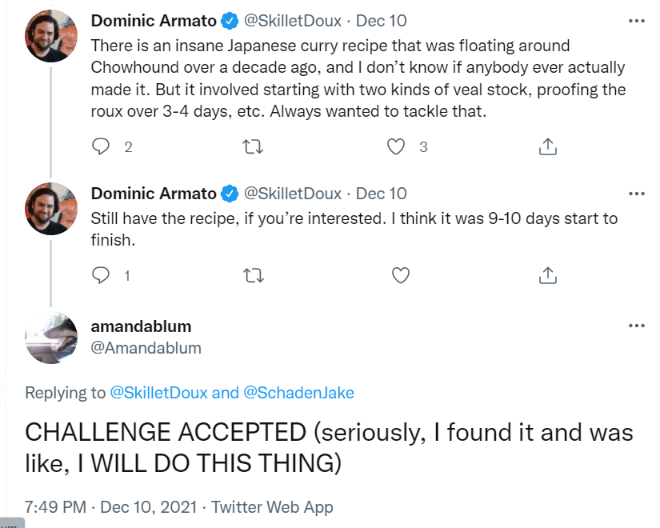
And now, in the name of history and search engine optimisation, I present the only photos in existence of the Gala Goose, along with a recipe, which you should not attempt. (Again, just roast it as described in the duck blog, or sous vide it if you must get fancy. Either will taste much better than the following.)
Gala Goose (Adapted from Sally Kofke, D’artagnan’s Glorious Game Cookbook)
- 1 goose, 4-5 kgs
- 3 tablespoons rendered goose fat
- 1 1/2 cups each coarsely chopped carrots, onions and celery
- 6 tablespoons flour
- 4 cups chicken stock
- 2 cups dry white wine
- 4 sprigs flat leaf parsley
- Peelings from 1 green apple
- 6 whole cloves
- 1 large bay leaf
- 28 g dried porcini mushrooms, soaked, cleaned and coarsely chopped.
- ½ cup dried cherries
- 2 tablespoons armagnac
- Salt and pepper
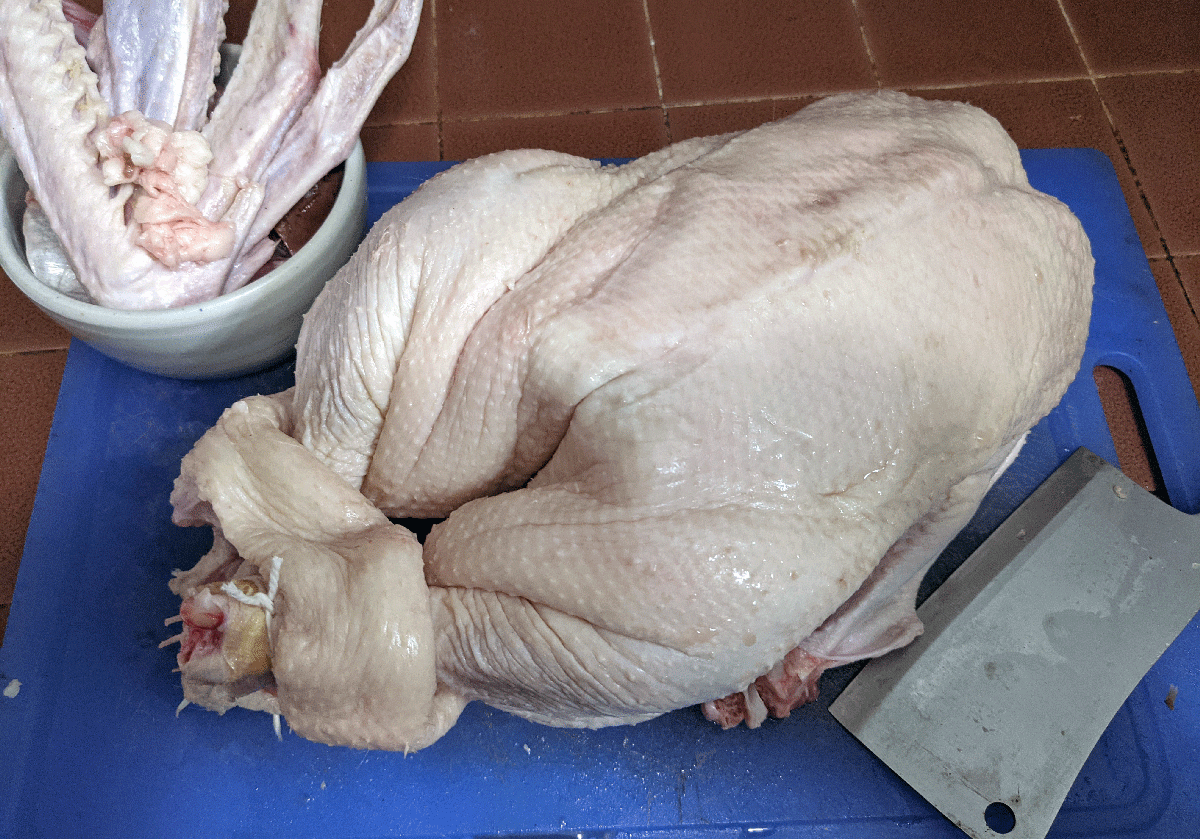
Remove everything from the cavity of the goose. Cut off the first two wing joints and any loose fat. Prick the skin of the goose all over the body.
Put this loose goose fat into the largest sauté pan you own, and render the fat until liquid. If there isn’t enough fat, you can sub in some from your freezer or use olive oil, duck fat, or schmaltz.
Use a corn cob holder to prick the skin, and then shibari the goose.
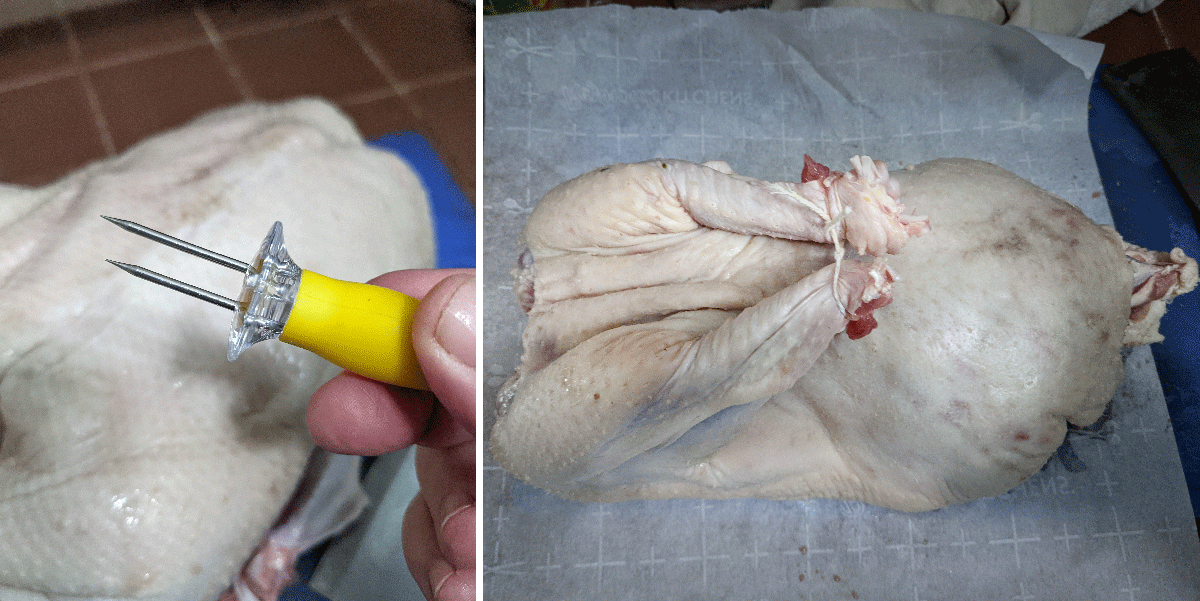
If there’s room in the pan, add all the giblets, wing pieces, neck and chopped vegetables. If there’s not, do this step in two batches. Sauté until the vegetables are browned, 7-8 minutes, turning frequently. Sprinkle on flour, adjust heat to medium, and continue cooking until flour is lightly browned, 6-7 minutes, stirring often.
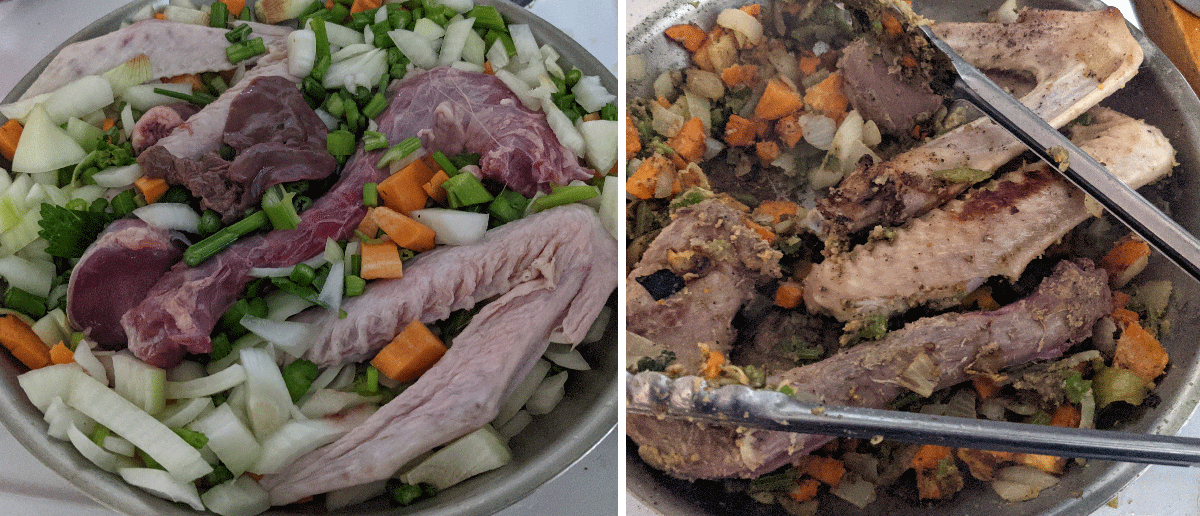
Pour chicken stock and white wine into a roasting pan large enough to hold the goose with the lid on. Place a rack in the bottom of the pan, and then lower the goose in, breast side down, in a sling of parchment paper. Tying up the bird so that it is compact and has a handle on both the breast and thigh side is helpful here.
Add browned giblets and vegetables, parsley, apple peelings, cloves, and bay leaf to the liquid. Pour in enough water to cover goose two thirds of the way up its body, and bring to a simmer.
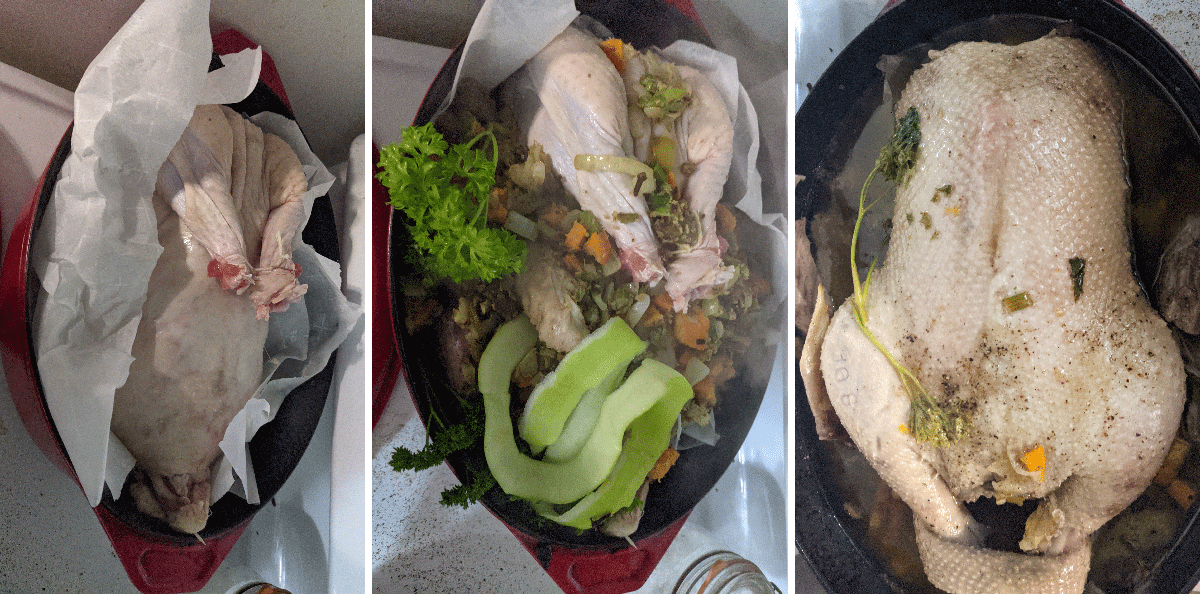
Remove a cup of this liquid with a baster, add it to the sauté pan used in step 2, and deglaze the pan. Scrape the thickened liquid back into the roasting pan. Cover pan and cook very gently, regulating heat if necessary, to keep it just simmering.
After an hour, turn the goose over, being careful not to break the skin. Rubber gloves are advised, and at this point, you can remove the parchment paper altogether.
Poach goose a total of two or three hours, or until meat is tender when pierced with a fork.
Preheat oven to 230°C.
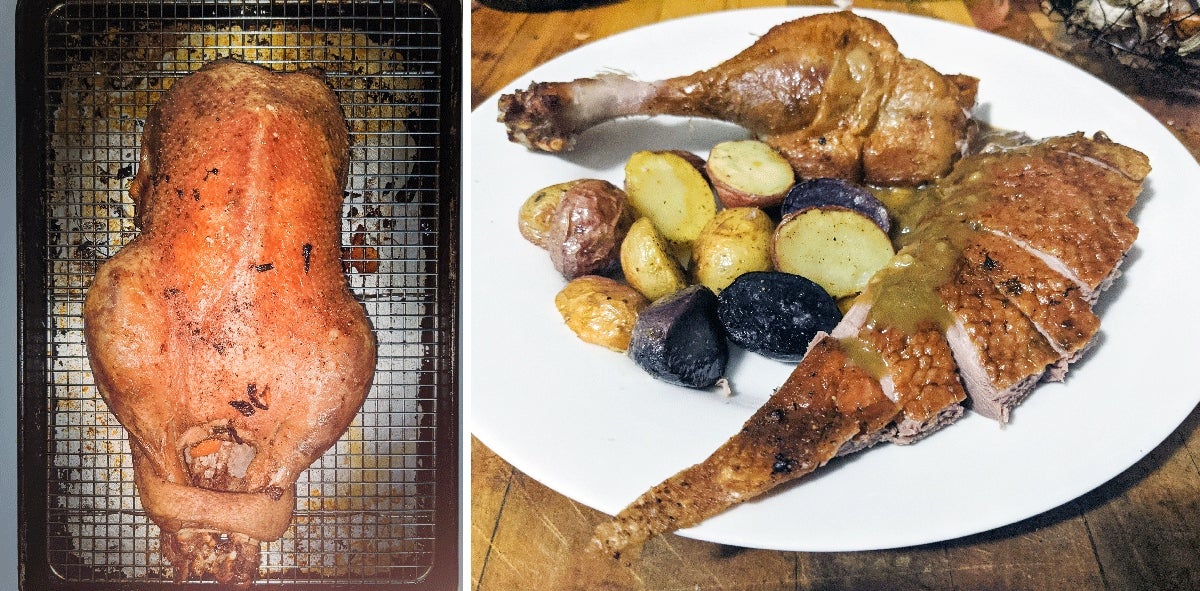
Remove goose from the liquid, drain and place on a rack, breast side up in a shallow roasting pan. Roast until skin is brown and crispy, about 30 minutes. Remove from oven, and allow to stand for about 15-20 min before carving.
Take the liquid from the roasting pan and skim the grease and anything else out, so you’re left with just liquid. Discard pieces of goose and seasonings. Purée vegetables and add back to the pan with the strained liquid. Boil quickly to reduce liquid by about half.
Add porcini and their strained soaking liquid, cherries, Armagnac, and red currant jelly. Season sauce to taste with salt and pepper, and keep warm until needed. (It will never be needed, because — once more — you should never make this goose.)
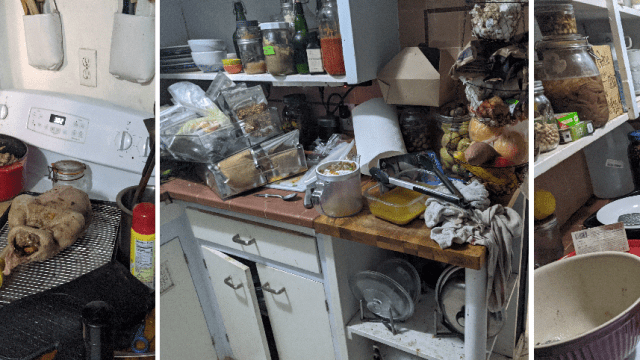
Leave a Reply
You must be logged in to post a comment.